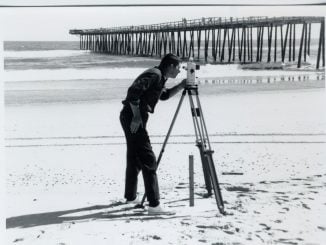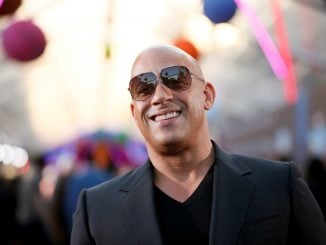As fans trickled into Lucky J Arena for the last regular-season North Carolina High School Rodeo Association competition on May 7, Bruce Adams sat in a small space in his trailer, expertly smearing face paint on to his wrinkled, tanned skin while his shaggy dog, Mac, lay at his feet. He was already wearing his signature American flag suspenders and blue, yellow, and red striped shirt embellished with white fringe.
When the look was completed, Adams had morphed into Chico, his rodeo clown alter ego for the last 30 years. Some years he’s done as many as 40 rodeos, but this year, his last before he retires, Adams is doing just 10.
Adams, of Boiling Springs, N.C., is one of the last remaining pillars of tradition in the sport. Before he was a clown, he was a bullfighter, fully dressed in eccentric clothing to distract and corral the bull after he bucked off a rider. Now the American matadors dress in more muted outfits, occasionally wearing a boldly patterned shirt or purposefully tattered jean shorts.
“It’s time for someone else to take over,” he said. “The people I used to do it with are out here with their kids now. It’s all changing. That’s not necessarily a bad thing, but it’s changing.”
At the same time Adams was preparing for the night’s show, girls and boys from all over the state prepared for their events in the field behind Lucky J, practicing techniques they’d soon show off in front of hundreds of people in an event that exists at an intersection of southern values and Wild West traditions.
Faith Toberer stood in a rodeo layup line between two horse trailers, waiting for her turn to rope a plastic calf with borrowed a lasso. She’s just five years old, but wearing miniature boots and a pink shirt embellished with a ‘cowgirls rule’ glitter logo, she’s already firmly indoctrinated in the sport. Her older brother Zack leads the high school division in steer wrestling and tie down while her brother Jake is the top chute dogger, goat-tier, and bull rider in the junior high school division.
Her sister Grace, 10, isn’t old enough to compete yet either, but she’s practicing roping calves, too.
“We’re set up for rodeo and nothing else,” said their father, Mike Toberer. “If she wants to play softball, we’re in trouble.”
With the schedule set by the rodeo producer of the host arena, rodeo setups vary by location. The producer at the Lucky J Arena wanted to have two-and-a-half hour evening shows Friday and Saturday. But with more than 50 kids entered in the various events, there wasn’t enough time for everyone to go in that timeframe.
A random lottery pulled a few competitors for each event to perform during the actual spectator rodeo, and afterwards, the rest of the field ran through their events in another rodeo called “slack,” that ran until nearly 2 a.m. both nights. It’s crucial that everyone entered gets to compete in their events because they earn points for their performances, and at the end of the season, the top four point totals in each event qualify for either high school nationals in Gillette, Wyoming or junior high nationals in Lebanon, Tennessee.
For the nearly 95 kids in the NCHSRA involved in daily individual practices, midweek races, and about 16 regular season rodeos all over North Carolina leading up to the state finals in Yadkinville during Memorial Day weekend, the sport can be incredibly grueling and expensive. Many families have their own farms and build their own practice corrals. But even with obvious obstacles, the sport rooted in ranch duels of the late 1800s is growing, ushering in as many as 20 new participants in the NCHSRA this season alone.
Each rodeo has cash prizes for top winners in each event. It isn’t always a lot of money, but it can help cover the entry fees, ranging from $30-35 per event, and upkeep for their horses. Some kids even enter professional events where there’s a chance to win trucks and trailers.
The rodeo also offers an opportunity to get some of their education paid for with colleges like Tennessee-Martin and Black Hills State offering spots and scholarships on their rodeo teams.
“It’s a great sport to raise your kids in, great community, really safeif you call strapping your kids on a bull or a horse safe,” NCHSRA national director Kate Scott said with a laugh. “But then again, it’s safer than what some of those kids are doing out on the football field.”
But of course, there are inherent dangers that come with riding giant animals, ones that Casey Lemmons knows all too well. Three weeks ago, Lemmons was minutes away from being airlifted out of the arena.
A day after being thrown from her horse in competition, Lemmons tried to get back in the arena during the second day of a rodeo. But when her horse got spooked by the cracking of a whip and jolted forward, Lemmons’ neck snapped back, and she blacked out. Immediately, bystanders knew something was wrong and rushed to pull her off the horse.
“I was down on the ground and I heard them say, ‘She might be paralyzed. We need to get her in a helicopter,'” Lemmons said. “That’s when I started hearing again. I could see everything, but I couldn’t do anything. I couldn’t move my body.”
But after fearing the worst, Lemmons left the hospital 11 hours after arriving by ambulance, diagnosed with a cervical sprain, torn neck ligament, and a concussion.Lemmons, who’s been riding horses since she was six months old, has one
more week left in a cervical collar, and she hopes to be ready to compete again
by the state rodeo. But by then, her leads in barrels and poles racing will have
evaporated, making her odds at nationals incredibly slim. “I think it’s the most dangerous because you never know what a horse or a
cow or anything is going to do,” she said. “You never know when they’re going to
decide that they don’t want you on their back anymore.” But even with her recent injury, Lemmons isn’t scared about getting back in
the saddle. Much like everyone else on the circuit, rodeo is in her blood, and she
can’t imagine doing anything else.
© 2022 — North State Media LLC



